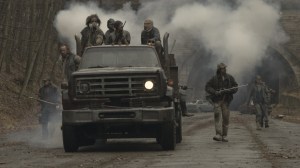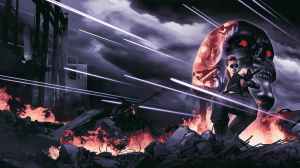“Gotham By Gaslight”

As a murder mystery, I don’t think Brian Augustyn’s script holds up so well. I haven’t seen the animated movie that premiered over the weekend at DC’s Washington D.C. event, but I’d bet it’s the first thing the screenwriters bulked up. I’ll bet they added characters to be potential murderers, all of whom have questionable characteristics and flimsy stories along the crime’s timeline.
Videos by ComicBook.com
It’s not that the logic behind the crime or the way it’s laid out is at fault. I knew who the murderer was before there was even a mystery, though. It was too obvious. I never guess right on these things, and I wasn’t even guessing. I just knew it. When the red herring got tossed in, it was a blatant attempt as misdirection, for me.
Part of the problem is that the book is short. It’s only about 48 pages. Things happen quickly, and there’s not enough space to add the complexity to the script that it needs to be more suspenseful. The only thing about the murder mystery that kept my interest is that because this was an “imaginary story”, anything could happen, including Batman getting caught or going to jail or some crazy left turn like that.
In a particularly bad bit of timing, the back story that is revealed as part of the confession involves the killer invoking Martha Wayne’s name, which made me flashback to Batman vs. Superman. I shuddered.
It might sound weird to follow that up with this: I enjoyed the book a great deal, even when the core conceit of it — a murder mystery — didn’t work out so well. It’s not so much about the series of events or the mystery of the thing, but rather the overall feel of this world and the clever ways it’s used to recreate the Batman mythology.
Beginning the Elseworlds
This was the first “Elseworlds” book, though the label hadn’t been devised yet. The inside front cover gives the book the full title of “GOTHAM BY GASLIGHT: AN ALTERNATIVE HISTORY OF THE BATMAN”.
Close enough.
It was Prestige Format, complete with the cool cardboard cover and square spine. It contained no ads. In 1989, this largesse only cost you $3.95, which is still cheaper than what you pay today for 20 pages of story.
Augustyn does everything you’d expect a book like this to do. He expertly recasts the murder of Bruce Wayne’s patterns, diverts Bruce to Europe instead of Asia for training, has him meeting Freud for some impromptu analysis, and getting caught up in the Jack the Ripper story along the way. It’s a clever way to recast a character into a different era and hit many cultural touchstones in a way that makes sense.
Look, the last known occurrence of Martha Wayne dying that didn’t involve a broken string of pearls:

If you’ve read “From Hell” before, you know all you need to know to get the references to the original murders. If not, Augustyn fills you in to keep you going, but knowledge of the history will give you a slightly deeper appreciation for what he’s doing in his script.
Before this story became the template and got repeated ad nauseum, it was a pretty solid story with flourishes of awesomeness of its artist.
The Art of Mignola
This is relatively early work for Mike Mignola. It’s after “Rocket Raccoon,” but still before “Hellboy.” You can see all the tics of Mignola, even if the final polish and skills aren’t completely there yet. (Where are the inset panels? The random statues and birds are inside the panels!)

There are a few statues that stand out to me. You can tell Mignola really enjoyed drawing them and wanted to add more of them. They played to his strengths, so we can forgive them.
Also playing to his strengths: A man in a bat costume at night in a city during the Victorian period. You get lots of inky blacks, some smoke and fog, and period costumes. It’s great.
That said, it’s his early work. The coloring saves it in a few places by emphasizing certain parts and helping to hide others. There is an establishing shot of buildings in Gotham that looks unfinished and flat. The scene is set in broad daylight, so the trademark Mignola shadows aren’t there, and the colorist, David Hornung, kept things relatively flat and bright. At night, when the shadows are in play and different colors reflect different amounts of light, things perk right up and you get interesting and dynamic panels.

I call the above image “Gotham By Sunlamp.”
By the way, if you’re like me and can’t remember Hornung’s name, there’s a good reason for that. He didn’t do much comics work. He did the run of “Sandman Mystery Theater” and that’s it. He left comics after that. It appears he’s a fine artist type today.
P. Craig Russell is the inker for the book. Russell is an amazing illustrator all his own, and pairing him up with Mignola seems like a natural fit. It was. Their skills and technique complement each other well, I think.
Russell goes for a little extra crosshatching in the backgrounds to help smooth out shadowy areas that doesn’t work so well. It’s a technique that was more common in that 1989 time frame before Photoshop made gradients work everywhere. Here, though, I just don’t buy it as much, perhaps because I’m more familiar with Mignola’s later work.
Lettering comes from John Workman, who’s always a master. His lettering feels extra large in this book for some reason. I’m not sure why. Maybe modern computer lettering has taught us to expect something smaller and tighter?
Recommended?
Yes. If you plan on watching the animated movie, then it’s a must read.
Even without the movie, though, it’s an enjoyable experience that marks a big moment in DC’s publishing program of the 90s with the establishing of the “Elseworlds” label based on this book. Plus, Mike Mignola draws Batman in such a way that you only need to half squint to smooth out the rough edges of his youth.
The current edition of this book quietly pairs it with Augustyn’s sequel story, “Master of the Future.” I’ve not read that one, but it has Eduardo Barreto art in it, so it’s automatically worth looking at.
Update
Last week, I called Adam Hughes’ “WildC.A.T.s/X-Men” story “unreprintable.” It still hasn’t been reprinted, but it IS worth nothing that the delayed “Absolute WildC.A.T.s by Jim Lee” book reprints the “WildC.A.T.s/X-Men: Silver Age” book that he drew. So maybe it isn’t quite as far-fetched as I thought?
I’d love to know how this happened. Was there a loophole in the original contract? Is Marvel allowing it because they want to keep Jim Lee happy? Was this the trade-off of good will be using the trading cards as covers?
Is it possible that the two companies came to a publishing agreement in the year 2017? That would be an unexpected thawing of relations… Welcomed, but unexpected.
PipelineComics.com|| Twitter || Instagram || E-mail || YouTube








